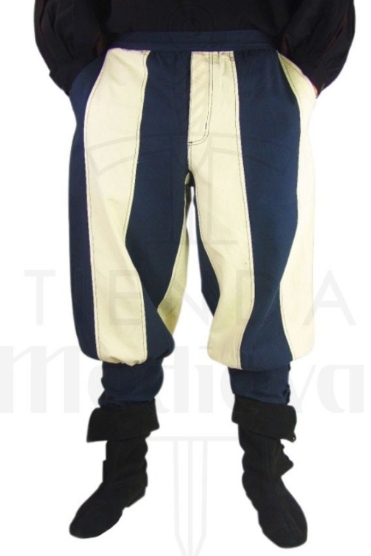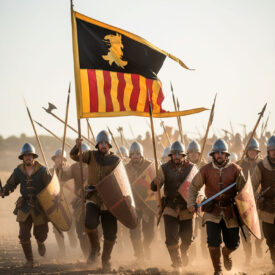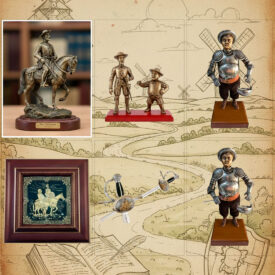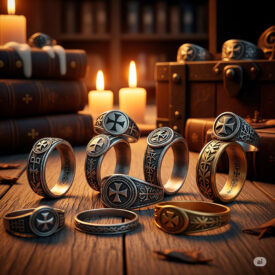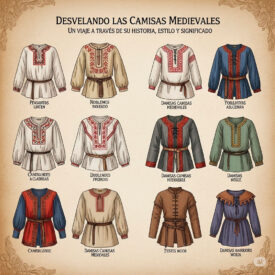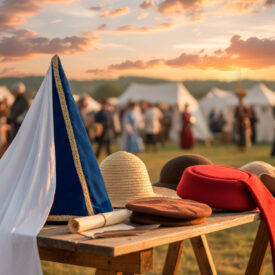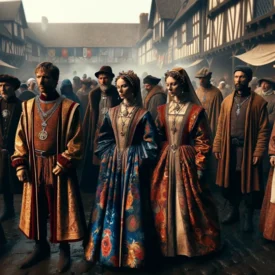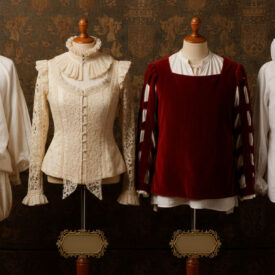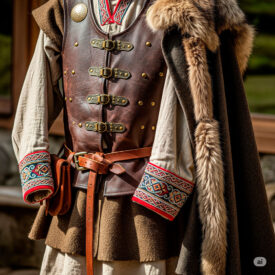If you have ever wondered how men dressed in the time of Miguel de Cervantes, you have come to the right place. Beyond the elegant doublets and the famous ruffs, there was an essential garment that defined the male silhouette of the era: the gregüescos, often popularly known as “Cervantine pants”. We invite you on a fascinating journey through this historical garment that shaped Spanish fashion during the Golden Age.
The arrival of Charles V in Spain marked a turning point in fashion, establishing a new order of dress. The old one-piece garments, such as briales, gave way to a set of separate pieces that divided the body: the torso was covered with doublets and ropillas, while the legs were dressed in hose, often completed with voluminous short trousers that wrapped around the thighs, known as gregüescos or valones.
What Exactly Are Gregüescos or Cervantine Pants?
Gregüescos are, in essence, very wide and puffed breeches that enjoyed great popularity in the 16th and 17th centuries. Although believed to have a military origin, their use quickly spread throughout society, becoming an icon of Spanish fashion at the time and adapting in style and size over the years.
Origin and Evolution: From Court to the Streets
Initially, gregüescos were a luxury item, reserved for the nobility and the court. However, their comfort and practical design made them popular. One description from the period defines them as wide trousers, gathered at the waist and open at the front, with “three-quarter length legs”, meaning they reached down to the knees. Over time, and due to the pragmatics of the Count-Duke of Olivares in 1622 that aimed to curb excessive luxury, the most ostentatious models were banned. This prompted gregüescos to adapt for more common civilian use, while the upper classes adopted new, tighter breeches of French influence.
Key Features: More Than Just Pants
Cervantine pants were not a simple garment. Their construction involved several layers and details that made them unique:
- Volume and Structure: They were characterized by their puffed shape, achieved through inner linings and sometimes padding. A typical pair could have up to three layers: outer strips of wool cloth, an intermediate layer for volume, and an inner cotton lining.
- “Slashed”: Many luxury models featured vertical openings, known as “slashes”, revealing the lining fabric, often in a contrasting color and made of a rich material such as silk.
- Functionality: They had side pockets, called “faltriqueras”, very useful for keeping money or small personal items.
- Fastening: They fastened at the front with laces and eyelets. In addition, eyelets at the top of the waistband allowed them to be attached to the doublet, ensuring that the whole outfit stayed in place.
Practical Differences: Gregüescos, Valones or Hose?
It is common to confuse these terms, but each refers to a specific garment in men’s clothing of the Golden Age. Understanding their differences is key to appreciating the fashion of the period.
Gregüescos: Volume and Prestige
As we have seen, gregüescos are the wide, puffed trousers that covered the thighs. Their main feature was their volume and, in more elaborate designs, the slashes. They were the central piece of the lower part of the body and a clear indicator of social status.
Hose and Valones: Their Inseparable Companions
Hose were garments that covered the legs. Originally, they extended from the feet to the waist. With the advent of gregüescos, the hose became shorter, covering from the knee down, giving rise to “half-hose”, the direct ancestor of today’s stockings or socks. Valones were a variant of gregüescos, also wide but often simpler and of military origin. Over time, the terms gregüescos and valones were used almost interchangeably.
Gregüescos in Golden Age Society: A Symbol of Status
As Cervantes said through Don Quixote, “Always dress well, friend Sancho, for a well-dressed stick does not look like a stick… As they see you, so they treat you…”. Clothing was a mirror of society, and gregüescos were no exception.
The Clothing of Nobles and Hidalgos
The nobility and hidalgos, like the 32 families living in Cazorla, imitated the fashion of the court. Their gregüescos were made of silk, brocade, and velvet, with rich embroidery and brightly colored linings visible through the slashes. The volume was sometimes so exaggerated that critics like Francisco de Enciso Zárate mocked them, describing them as “saddlebags” or “bladders” filled with “thirty yards of cloth and silk and old mats”.
The Attire of Soldiers and the Common People
For those who could not afford such luxury, like the soldiers of the Tercios or peasants, gregüescos were much more functional. They were made from durable and inexpensive materials such as woolen cloth or cotton. They were loose to allow freedom of movement and paired perfectly with gaiters or the shafts of tall boots, providing daily protection and comfort.
How to Wear Gregüesco Pants Today?
Today, gregüesco pants are a fundamental piece for historical reenactments, medieval fairs, Golden Age festivals, and stage productions. Achieving an authentic outfit requires attention to detail.
Tips for Historical Reenactments and Period Parties
If you want to portray a 16th or 17th-century character, choosing gregüescos is crucial. Research the social status you wish to represent. Are you a noble? Opt for richer fabrics and slashed styles. A soldier or an artisan? Choose woolen cloth or cotton in earthy colors. Consistency and historical accuracy are key.
What Accessories Do You Need?
An outfit with gregüescos isn’t complete without accessories. You’ll need:
- A period shirt: Generally made of linen or cotton, with simple collars and cuffs or lace, depending on status.
- A doublet or ropilla: The fitted “jacket” covering the torso to which the gregüescos are attached.
- Hose or stockings: To cover the lower legs.
- Appropriate footwear: Leather shoes, ankle boots or tall boots.
Buying Guide: What to Look For When Choosing Your Cervantine Pants
When buying cervantine pants, whether for a party or a reenactment, keep the following aspects in mind to make an accurate and authentic choice.
Materials: From Wool to Cotton
The material not only determines the look, but also the comfort and historical fidelity. Wool is ideal for a robust and authentic look, perfect for soldiers or peasants. Cotton is a lighter and more breathable option, very versatile. For a noble, look for blends that imitate velvet or silk, offering the suitable shine and drape.
Cut and Volume: Keys to Authenticity
Pay close attention to the pattern. Good gregüescos should have the characteristic gathering at the waist and generous volume in the thighs. The length should reach the knee or just above. Slashed models offer greater visual impact and are perfect for high-status characters. Make sure the fastening system (generally lace-up) is functional and sturdy.
Find the Best Period Trousers for Your Outfit
Transforming your appearance and traveling back to the Spanish Golden Age has never been easier. Whether you wish to become a brave Tercio soldier, a cunning hidalgo like Don Quixote, or a cheerful villager at a period festival, choosing quality gregüesco pants is the first step. Explore our selection and find the cervantine pants perfect to bring your historical character to life with the authenticity and quality you’re looking for.

